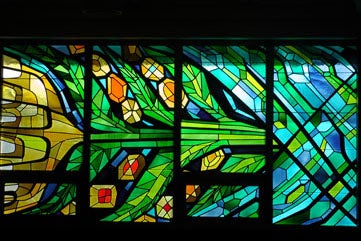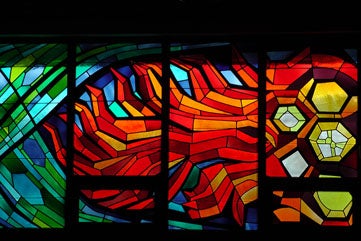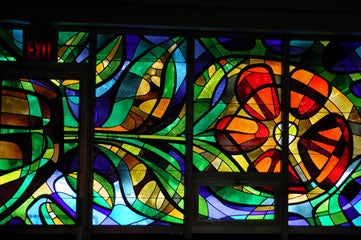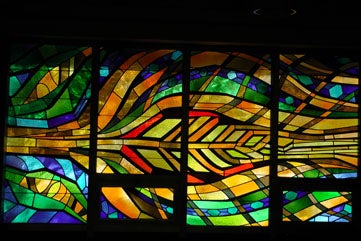Chapel Use
The Chapel at Grebel is used throughout the term in a variety of ways. Each Wednesday at 4:30 (4:45 in Spring term) we host a chapel service open to the University community. We also host free noon hour concerts, check our events listing to find dates and details. Additionally, the space is used for recitals, choir practices, student gatherings and more.
This sacred space is surrounded by earth and light. The east wall is built of stone, while the walls to the north and south house our well-known stained glass windows. The dance of color on a sunny day makes this a wonderful room a delight to be in. For the history of the windows... keep reading.
The Chapel windows
Grebel's striking stained-glass windows were designed to symbolically reveal the story of the life and faith of Mennonites and their Anabaptist forebears.
They were designed by local artist, professor, writer, scholar, teacher, novelist, and poet Nancy-Lou Patterson, who passed away on October 15, 2018. Her paintings, drawings, calligraphy, stitchery and stained-glass window designs can be found in churches and public and private collections in Canada, England and the United States. As well, her mythopoeic drawings and illustrations have been exhibited widely and published in many books and journals. She wrote on native, Mennonite and ethnic art, and about fantasy and mythopoetic art and literature. Of all her stained-glass designs, Patterson said that those she designed for the Conrad Grebel University College chapel were the most challenging.
All the symbols used in the Conrad Grebel Chapel windows are drawn from the natural world - fire, water, earth and growing things. The windows are divided into two parts. On the right hand of those observers entering the chapel and facing the chancel, is the group of windows representing the history of Mennonite faith and life in relationship to the world. The left hand windows represent the history of Mennonite faith and life in relationship to itself. Each group of windows reflects the other and both point the viewer toward the true focus of attention in the chapel - the chancel, with its pulpit-lectern and communion table.
Windows to the right


The right hand windows contain three symbols. Closest to the entrance door is the symbol of fire, representing the Mennonite witness to peace and nonresistance, which historically occurred amidst great persecution. The coals of fire within are varied, for even in their origins Anabaptists were loyal to different groups. The central symbol of the right hand windows is the water of baptism, shown in the form of a cross, drawing together all things and transforming them. Beyond is it the tree of religious liberty, suggesting the Anabaptist conviction that Christ's church answered to no secular authority. At the crown of the tree is a large blossom: the flower of the one true church of the future when Christ returns in splendor, and the separate churches - represented by the many individual blossoms on the tree - are drawn into one.
Windows to the left


The left hand windows also contain three symbols. Closest to viewers facing the chancel is the symbol of the earth, representing the Mennonites' origins in and close containing relationship to the soil. The central symbol is the flower, one of the most common designs used by people of many nations to ornament their bibles, pottery and sewing. With the Mennonite church having grown tremendously outside of traditional European roots, Mennonites are now truly a world community. The symbol closest to the chancel is the Wheat. An early Hutterite hymn says the church is a head of wheat, the individual kernels being the members, holding together a united head, itself separated from the world. This separateness is a significant part of Mennonite tradition and the wheat shows how the church continues to be "in the world but not of it."